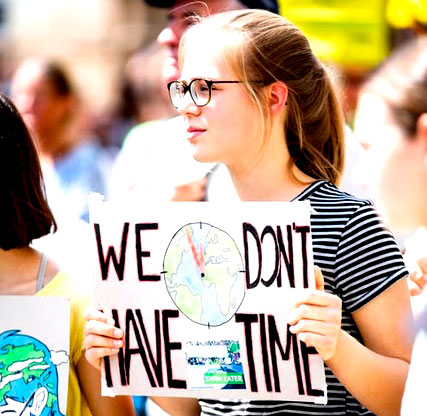Introduction
At GTEC’s recent Town Hall I was surprised to meet several people who told me they were confused about the climate crisis. What is the situation exactly? Where do we stand? When I thought about the flood of information that we encounter everywhere we turn from social media to the news on TV, I understood.
The Warming Planet
The Earth has warmed 1 degree Celsius (1.8 degrees Fahrenheit) since the 19th century. This warming is mostly caused by the carbon dioxide emitted by extensive use of fossil fuels in industry, agriculture and transportation.
One of the recent reports of the United Nations Intergovernmental Panel on Climate Change (IPCC), made up of many of the world’s leading climate scientists, addressed the relative consequences of an increase of 1.5 or 2 degrees Celsius. This report was released during the fall of 2018 – https://www.ipcc.
Arctic Ice
At an increase of 1.5 degrees Celsius, Arctic ice will remain most summers. At an increase of 2 degrees Celsius ice free summers will likely prevail threatening habitat losses for polar bears, whales, seals and sea birds. On the other hand, warming temperatures could benefit Arctic fisheries.
Drought and Fire
At an increase of 1.5 degrees Celsius, 14% of the world’s population will experience extreme heat waves once every five years, whereas at an increase of 2 degrees Celsius the percentage is 37%. Rising temperatures also increase the probability of difficult to control fires.
The difference between increases of 1.5 degrees compared to 2 degrees Celsius will affect the number of people exposed to severe drought. The difference is 350 million plus versus 411 million plus people. This difference will also affect the extent of habitat loss for insects, plants and vertebrates.
Coral Reefs
At an increase of 1.5 degrees Celsius frequent losses of coral reefs will continue. At an increase of 2 degrees Celsius coral reefs will be a thing of the past.
Sea Level
Increases in global warming cause rises in sea level. Populations exposed to extensive flooding increase from 31-69 million at an increase of 1.5 degrees compared to 32-80 million at an increase of 2 degrees Celsius. Crop yields, especially in sub-Saharan Africa, Southeast Asia, and Central and South America will be affected.
Response by Governments
Nations have delayed curbing their greenhouse gas emissions to the extent that warming of 1.5 degrees Celsius (2.7 degrees Fahrenheit) is now all but inevitable. Two degrees Celsius (3.6 degrees Fahrenheit) or higher this century is more likely.
Non-uniformity of Effects
Each time the Earth heats up an extra half-degree, the effects aren’t uniform. Some regions, such as the Arctic, will heat up two to three times faster. For example, the warming of the Canadian Arctic currently exceeds the global average.
The odds of extreme weather events like severe heat waves or powerful rainstorms also don’t increase uniformly with each half-degree. The number of extremely hot days around the world, for example, tends to rise exponentially as the global average temperature increases.
Tipping Points
Tipping points refer to the point at which a series of small changes or incidents add up and cause a larger, more significant and typically irreversible change. Tipping points are difficult to predict because they happen when many factors come together.
The recent IPCC report highlights the possibility that even modest amounts of warming may push both human societies and natural ecosystems past certain thresholds where sudden and calamitous changes can occur. For example, parts of the world may become uninhabitable causing mass migrations of people, animals and insects.
Another example of a tipping point is the irreversible disintegration of the vast ice sheets on top of Greenland or West Antarctica. These ice sheets could start to destabilize at 1.5 to 2 degrees of warming, resulting in many metres of sea level rise worldwide for centuries to come.
Transformation of Global Energy Systems
Holding warming to 1.5 degrees requires an immediate transformation of the global energy system. Global greenhouse emissions need to fall in half within 12 years and zero out by 2050. To stay below 2 degrees, emissions have to decline to zero by around 2075. Virtually all of the coal plants and gasoline-burning vehicles on the planet would need to be quickly replaced with zero-carbon alternatives. In addition, the world has to develop and deploy carbon sequestering technology to remove billions of tons of carbon dioxide from the atmosphere each year. Other than carbon sequestering technologies, still untested at scale, greening the planet with trees and edible crops is the best available alternative.
This week, the United Nations Environment Programme (UNEP) released its annual Emissions Gap Report compiled by 57 leading scientists from 33 institutions across 25 countries. It calls on governments to act immediately, within the next decade, to limit global warming to 1.5 C or 2 C by 2100. Currently, we are on the path to an increase of average temperatures globally of 3.2 C.
Greenhouse gas emissions (GHG) have to drop by 2.7 per cent per year from 2020 to 2030 for the 2 C goal, and by 7.6 per cent per year for the 1.5 C target.
——————————————————————————————————–
For a New York Times article that compares the compares the relative effects of increases in global warming of 1.5 versus 2 2 degrees Celsius see https://www.nytimes.com/interactive/2018/10/07/climate/ipcc-report-half-degree.html
https://www.cbc.ca/news/technology/un-emissions-report-1.5373154 CBC report on the United Nations Environment Programme (UNEP) annual Emissions Gap Report .

